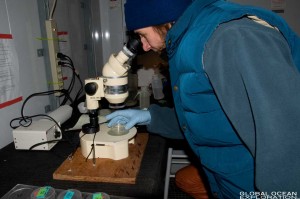
Yesterday, I had a chance to sit down with the chief scientist, Dr. Carin Ashjian, a zooplankton ecologist from the Woods Hole Oceanographic Institution, to find out more about the mission of the cruise, her role as chief scientist of the expedition and her research.Â
The mission of the cruise is to determine the importance of the ice and the seasonal melt on the ecosystem in order to determine how different ice conditions affect the ecosystem. Essentially, the scientists want to know how important the ice is and what would happen if there was no ice at some point in the future? On this cruise, the researchers are looking mostly at the base of the food chain, the phytoplankton, zooplankton, sea floor gas exchange and animals and some physical oceanography to put it all into context.Â
With twelve projects going on and forty-six scientists on board, there is a lot to manage and Dr. Ashjian must make sure that everyone gets the samples they need to complete their projects. This is quite a challenge! Many of the projects are time dependent or location specific so a careful plan is key. Unlike in the laboratory, variables change at sea so while a cruise plan may seem perfect while on land in the planning stages, sea conditions, weather and in the Bering Sea, the ice, may force the original plan to be changed. Improvisation and flexibility is the key but any changes must be made within the parameters of the project. For example, one team is studying krill and their samples must be collected at night. For this reason, we must be at the sampling location around 3am or the work cannot be completed in the dark. (The sun has been setting at 11:30 and the days are getting longer and longer.) Much of the work is collaborative so the samples must be taken at the same location. For this reason, most of the sampling is completed in the middle of the night. Dr. Ashjian is responsible for discussing the cruise plan with the Captain, officers and crew and making sure that everything runs smoothly.Â
In addition to the multitude of responsibilities associated with being chief scientist, Dr. Ashjian is conducting her own research on copepods and other dominant mesozooplankton (highlights coming soon). She adds that this is one of the most challenging jobs she has had. Thus far, all of the scientists are learning a lot and collecting samples to analyze when back in the lab.Â
Our next course of action is to look for areas of high production near the ice edge and continue sampling before heading north to do a specific transect in the ice on Sunday. Â
